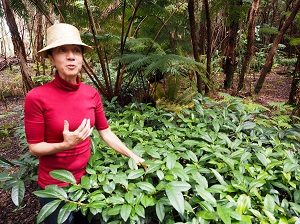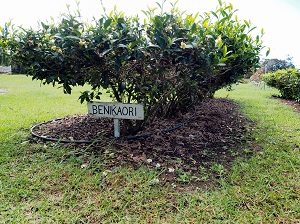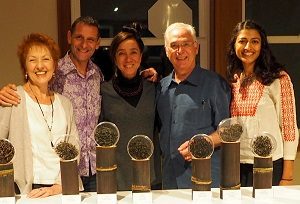Nothing is more hallowing than the union of kindred spirits in art.
Photography by Bruce Richardson
This quotation from Okakura Kakuzo’s classic Book of Tea is the mantra for Hawaii tea growers Eva Lee and Chiu Leong. The age-old sentiment is the refrain that infuses the lives of this talented couple as they grow tea in their rainforest garden nestled on the slopes of Hawaii’s Kilauea Volcano. Okakura would say their mission is steeped in the true spirit of teaism.

Lee, the daughter of an American mother and a Chinese father was raised in Connecticut where, as a teen, she discovered her artist spirit through the medium of dance. That art form carried her through college and taught her how to be focused, aware, balanced and disciplined. Her daily dance rehearsals helped her realize that a skill needs to be honed by repetition until it becomes second nature – a pleasure rather than a task; joy rather than work. Little did she know that the disciplines of dance were preparing her for a life in tea.
As a child, Lee heard stories of her fathers’ childhood in Yunnan Province. “His tales of ancestors, family, and place were related to drinking tea,” she says. “I longed to be a part of that culture.”
Leong is also first generation Chinese, born in Hollywood, who lived much of his life in California where he was a photographer and potter with a deep interest in the ritual of tea. Many of his first ceramic pieces were tea bowls intended for exhibition and decorative use in tea houses.
Lee and Leong both ended up in Hawaii where they met at a dance retreat for international artists held in the village of Volcano, a longtime haven for artists and scientists. Leong settled land only a few miles from the still-active Kilauea Volcano and the couple lived in a cabin off the grid, practiced their arts and raised a garden.
In 2001, Lee and Leong read newspaper reports about the resurgence of tea growing in Hawaii.
A Century of Tea Growing in Hawaii
Trial plantings of African tea bushes on the island date back to 1887. By 1892, the Hawaiian Coffee and Tea Company established five acres of tea plants in Kona. These early experiments by large tea producers failed because of high labor costs. Coffee growing, a $34 million annual crop today, took root because it was less labor intensive.
By 2000, Dr. Frances Zee, Horticultural Research Leader at the USDA station near Hilo, had begun growing tea plants as a possible replacement crop for the vanishing sugar industry. Reports of Zee’s work were published in local papers just as America’s languishing love for tea was re-awakening. His findings were encouraging.

Lee and Leong were captivated by this news and, after meeting with Zee, began clearing more ground. On their knees, they pulled up miles of invasive Kahil ginger root, protected the native ferns, and raised the canopies of the rain forest trees in order to let in much needed sunlight. They acquired seedlings – including yabukita, yutaka midori and benikaori cultivars – to plant in rows that fill their property. The couple named their enterprise Tea Hawaii and Company.
An Asian-style home was constructed in the middle of their tropical paradise, complete with a spacious studio that accommodated his pottery and her tea processing equipment. Mechanically-driven screens now raise baskets of withering or dried teas toward the roof, allowing the couple to roll and manufacture other teas in machinery that sits just feet from potter’s wheels and rows of clay pots fresh from the kiln.
Hawaii Tea Society
Over a dozen small tea gardens, all under ten acres, dot the Big Island while an estimated 30 or so growers may be found throughout the state. Most growers consider themselves part-time tea farmers and tea growing is still a sideline. Growers often sell their teas at farmers’ markets or to high end restaurants. Others have found tea retailers on the mainland or in Europe who purchase their unique products at prices up to $400 per pound – that’s many times over the wholesale price of a top Darjeeling. These small gardens may only produce around 40 or 50 pounds of tea per year, which only adds to the unique demand for such an artisanal product.
The growers I interviewed seemed to be fairly independent-minded. Similar to craft brewers or craft distillers, they love to experiment with new or unorthodox production methods in an attempt to create unique products. Many have taken advantage of educational programs offered through the Hawaii Tea Society, established years ago to encourage tea husbandry and marketing.

The Society, with Eva Lee at the forefront, organized the Teas of the United States (TOTUS) Awards, the first national tea competition specifically for USA grown tea, at the Volcano Art Center in Volcano Village in November 2015. The competition drew 79 entries from 10 states and 30 tea gardens across the United States. A panel of six international judges awarded four Hawaii growers, including Chiu Leong, the top prizes for commercial production.
A Cooperative Growing Effort
Eva Lee and Chiu Leong help process teas grown in other gardens as well, including Johnny’s Garden. John Cross has the oldest commercial tea garden in the state. The Cross family purchased their land, located along the Hamakua coast on the island of Hawaii, from a sugarcane company in 1993. The garden sits at 900 feet elevation and slopes gently toward a panoramic view of the Pacific Ocean.
Award-winning woodworker Mike Riley established his family-owned business that became Volcano’s first commercial tea garden in production. His Volcano Tea Garden is located at 3600 feet elevation on the slopes of Kilauea Volcano. The tea plants he grows are cultivars originating from China, Japan and Taiwan. Mike was awarded first prize by the TOTUS judges for his wulong tea.
Lee and Leong occasionally assist Alex Wood, manager of the Volcano Winery. Wood oversees both grape and tea production on this sunny farm facing the leeward side of Kilauea. The operation boasts a tasting room where both wines and teas are sampled. Wood won first prize for his white tea at the TOTUS competition.
Organic Growing
Tea Hawaii and Company are organic growers. I recognized that fact as I walked through the garden and listened to the chorus of birds in the treetops and the hum of bees searching for nectar. The owners have restored their 4000 feet elevation forest to host native flora and fauna by removing invasive plant species, such as strawberry guava and Kahil ginger, by hand and without the use of chemicals. Indigenous Mamaki shrubs have been brought back to the understory to serve as a nesting habitat for the Kamehameha butterfly.
“What makes Tea Hawaii unique is that they have achieved a beautiful balance of restoring the native forest while producing tea,” stated Bruce Petersen, NRCS Director for the Pacific Islands Area.
Talking with the TOTUS judges, Eva Lee explained her mission as being a spiritual calling: “I saw the tea plant as a sort of ‘nectar of the gods’, something that connected me to my ancestors, to my parents, to nature, to my home on the slopes of Kilauea Volcano. It was a perfect fit for Chiu and me.”
Okakura would say that is exactly the mission of tea.
To learn more on Hawaii’s rich bio-diversity, read Kevin Gascoyne’s terroir report.
To learn more on Hawaii’s tea industry, read Elyse Petersen’s insight.